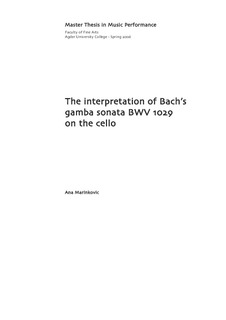| dc.description.abstract | The interpretation of Bach’s gamba sonata BWV 1029 on the cello deals with the
interpretation of gamba sonatas on the cello from the modern perspective. It is written in
the English language by Ana Marinkovic and it is 55 pages long. It is a master thesis
from the Agder University College, the Conservatory of Music in Kristiansand Norway,
the classical department.
Key words in my thesis are: Baroque style, analysis, interpretation, gamba and cello.
I am trying to explore the historical interpretation of Baroque music, through the
sonata BWV1029 which was written in that period by Johan Sebastian Bach (1685-
1750). According to L.Dreyfus he wrote the gamba sonatas in the late 1730’s in Laipzig.
If one wants to understand a piece and interpret it well, one first has to analyze that
piece. So I have been looking on the formal aspect of the sonata, harmonic and stylistic
aspect, and tried to take a closer look of these in my interpretation.
Regarding the interpretation, I first compared the playing on the gamba with the
playing on the cello, to sort out the general differences between the gamba and the cello
technique. I red some crucial literature on interpretation such as books and essays of
Thurston Dart , Richard Taruskin and Howard Mayer Brown. In this thesis I am trying to
show that we, as a modern musicians, do not need to long for “ pure Baroque style”,
while interpreting, but to be creative and try to find our modern point of view on Baroque
music from a “historical aware” viewpoint!
2
Thesis is divided into six sections.
The first section consists of short biographies of the authors whose works were
crucial to my work, and also the editions I have been using.
In the second section I am analyzing the BWV 1029 sonata, and I am giving some
reviews on forms characteristic for the Baroque period, such as the sonata and concerto.
The third section is about interpretation, and differences on the cello, and gamba
interpretation. I write about the Baroque and modern bow, about vibrato and graces and
tunings. In this section I also present two recordings, which I chose as my favorites.
Finally I write about my view concerning the thesis.
In the fourth section I present some thoughts and conclusions of my own.
In the fifth section (the appendix) I include note samples and schematic graph of the
second movement of the sonata.
The sixth and the last section contains a Bibliography. | en |
